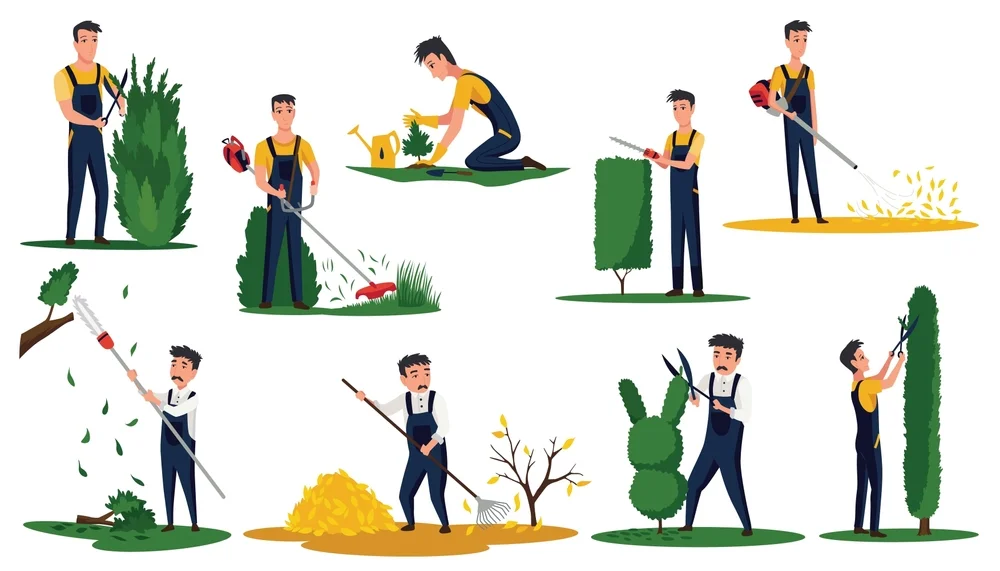
The satisfaction of creating your own personal garden space, even if it starts small, can be highly rewarding. And the mental and emotional benefits of a well-designed and well-maintained landscape are invaluable.
Have you ever looked out your window and envisioned your backyard as more than just a backyard?
While professional garden landscaping companies can create stunning outdoor garden landscape ideas, many aspects of landscape design can be attempted by DIY enthusiasts with little knowledge and planning.
Even simple improvements, like planting flowers, adding a small patio, or incorporating decorative elements, can significantly impact your happiness.
So, what are you waiting for? Let’s get into the steps involved in successful landscape installations!
Why Landscape Your Garden ?
Landscaping offers a number of benefits, enriching your life in several ways:
- Boosts Aesthetics: A well-designed landscape improves the visual appeal of your property, increasing its value and creating a welcoming first impression.
- Creates a Beautiful Outdoor: Converts your backyard into a perfect place for relaxation, entertaining loved ones, or simply enjoying the fresh air.
- Provides Privacy and Screening: Tactically placed plants and structures can offer privacy and block unwanted views, creating a sense of shelter.
- Promotes Biodiversity: Attract pollinators like butterflies and bees by incorporating flowering plants, contributing to a healthy ecosystem.
- Improves Air and Water Quality: Plants act as natural air filters, removing pollutants and releasing oxygen, while also helping with soil erosion control.
- Increased Value: A well-designed and maintained landscape can increase the value of your property, making it a worthwhile investment.
How to Landscape Your Garden Step-by-Step
Step 1: Design and Planning
- Assess your space: Measure your garden area, noting existing features like trees, structures, and slopes. Consider your sun exposure and drainage patterns.
- Draw a garden plan: Sketch your layout, including planting zones, walkways, patios, and desired features like a water feature or fire pit. Utilize online tools or graph paper for a basic plan.
- Set a budget: Determine how much you are comfortable spending on materials, plants, and tools.
- Research and choose plants: Select plants suitable for your climate, sun exposure, and desired functionality.
- Consider water conservation: Use drought-tolerant plants and implement mulching techniques to retain moisture and reduce water needs.
Step 2: Preparing the Soil
- Test your soil: Knowing your soil pH and nutrient levels helps you make appropriate adjustments.
- Clear the area: Remove weeds, debris, and any unwanted vegetation.
- Amend the soil: Add organic matter like compost or aged manure to improve drainage, fertility, and water retention. Consider tilling the soil to a depth of 6–8 inches.
Step 3: Planting and Creating Features
- Plant according to your plan: Follow the recommended spacing guidelines for each plant and ensure proper planting depth.
- Create features: Construct your patio, raised garden beds, or any desired features that you wish to have in your garden.
- Add walkways: Use stepping stones, gravel paths, or recycled materials to create pathways through your garden.
Step 4: Maintenance
- Ensure regular watering, especially in the first two weeks after planting. Adjust the watering frequency based on your plants’ needs and weather conditions.
- Weed regularly to prevent unwanted competition for resources.
- Fertilize according to your soil test results and your specific plant needs.
- Prune plants as needed to maintain their shape and encourage growth.
Landscaping Ideas on a Budget
- Upcycle old containers like tires, bathtubs, or chairs as planters.
- Use recycled materials like bricks, wood scraps, or pallets for edging, raised beds, or decorative features.
- Start your own plants from seeds or cuttings to save money on mature plants.
- Choose low-maintenance, drought-tolerant plants that require minimal watering and care.
- Focus on mulching to suppress weeds, retain moisture, and improve soil health.
- Use natural pest control methods like companion planting or homemade solutions to avoid expensive chemical products.
Who Can Landscape a Garden?
Anyone! Landscape design isn’t limited to professionals. Here are a few options for who can landscape a garden
Homeowners
If you enjoy gardening and have a knack for design, you can landscape your own garden. With some research, planning, and creativity, you can create a beautiful outdoor space that reflects your style and personality.
Professional landscapers
For those who prefer to leave the work to the experts, hiring landscaping companies in Dubai is a great option. Landscapers have the knowledge, skills, and experience to design and execute stunning garden landscaping ideas custom-made to your preferences and budget.
DIY enthusiasts
If you enjoy hands-on projects and want to save money, you can tackle home garden landscaping ideas as a DIY project. There are plenty of resources available, such as online tutorials, books, and workshops, to help you learn the basics and create your own unique garden design.
Community groups
Some communities have gardening clubs or volunteer groups that work together to landscape public spaces, such as parks, schools, or community gardens. Joining one of these groups can be a rewarding way to contribute to your community while learning new skills and making friends.
When is the Best Time to Start Landscaping
The best time to start landscaping a garden depends on various factors, including the climate, the type of plants you want to use, and your schedule. Here are some considerations for determining the best time to start landscaping
Season
In temperate climates, spring and fall are generally considered the best times to start landscaping. These seasons provide moderate temperatures and ample rainfall, which are ideal for planting and establishing new plants. However, landscaping can be done at any time of year, depending on the region and local weather conditions
Planting Season
Certain plants have specific planting seasons based on their growth habits and environmental requirements.
For example, many annual flowers and vegetables are typically planted in the spring after the last frost date, while perennials and shrubs can be planted in the spring or fall.
Research the optimal planting times for the plants you want to include in your garden.
Soil Conditions
It is essential to assess soil conditions before starting any landscaping project. Soil that is too wet or frozen can be difficult to work with and may not support healthy plant growth.
Wait until the soil is dry enough to be easily cultivated and enriched with compost or other organic matter.
Personal Schedule:
Consider your own schedule and availability when planning your landscaping project.
Starting a garden requires time and effort, so choose a time when you can dedicate sufficient time and energy to the project.
Weekends or days off from work may be ideal for beginning larger landscaping tasks.
Budget:
Your budget may also influence the timing of your landscaping project. Some materials and services may be more expensive during peak seasons, such as spring and summer.
Planning your project during the offseason or taking advantage of sales and discounts can help you implement garden landscaping ideas with low maintenance.
From planning and designing to planting and maintaining, each step plays a crucial role in the success of your garden project.
By following the step-by-step procedure outlined in this guide and having dedication, creativity, and a little bit of patience, you can create a beautiful and attractive garden landscape that you will love to call your own.



